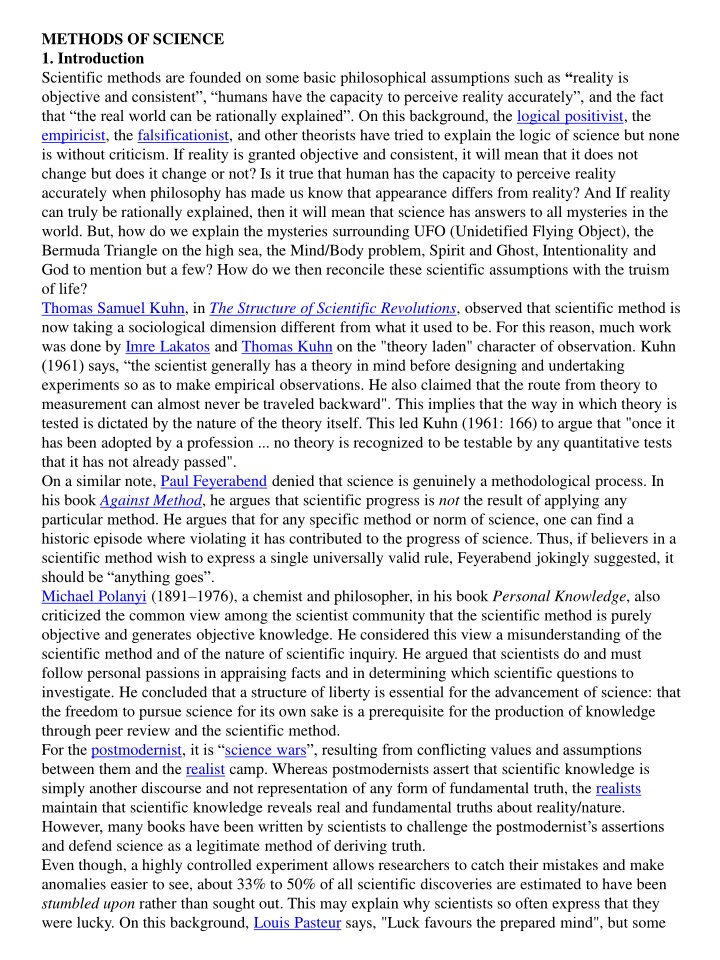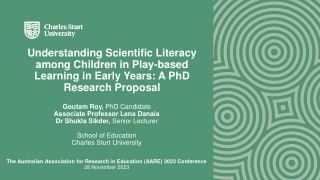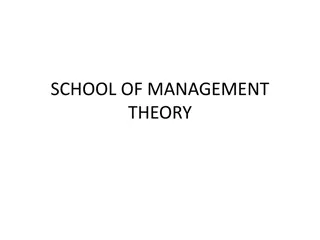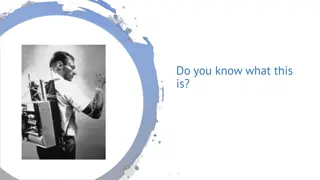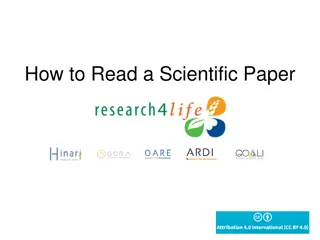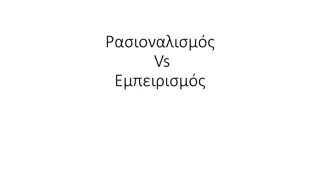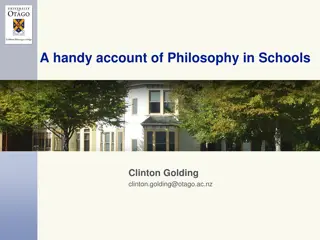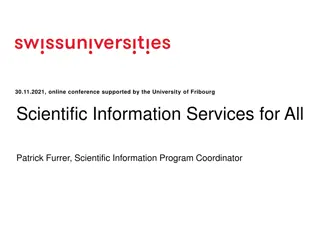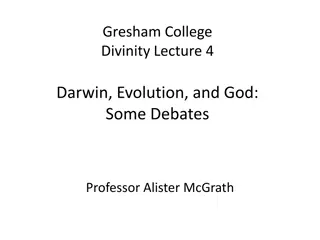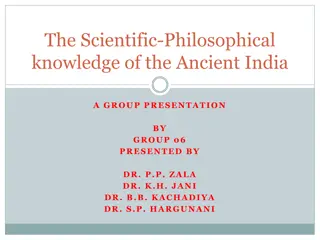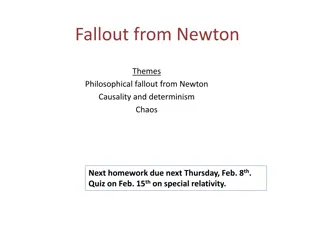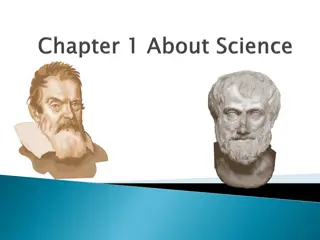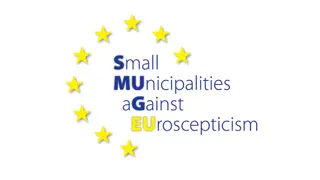The Evolution of Scientific Methods and Philosophical Debates
Scientific methods are built upon philosophical assumptions of objective reality, human perception accuracy, and rational explanations. The debate on scientific logic spans from theories of logical positivism to postmodernist challenges. Notable figures like Thomas Kuhn and Paul Feyerabend diverge on the methodological processes in science. Critics like Michael Polanyi argue for a more personal, liberty-driven approach to scientific inquiry. The discourse continues between postmodernists viewing science as discourse and realists upholding scientific knowledge as revealing fundamental truths about reality.
Download Presentation

Please find below an Image/Link to download the presentation.
The content on the website is provided AS IS for your information and personal use only. It may not be sold, licensed, or shared on other websites without obtaining consent from the author.If you encounter any issues during the download, it is possible that the publisher has removed the file from their server.
You are allowed to download the files provided on this website for personal or commercial use, subject to the condition that they are used lawfully. All files are the property of their respective owners.
The content on the website is provided AS IS for your information and personal use only. It may not be sold, licensed, or shared on other websites without obtaining consent from the author.
E N D
Presentation Transcript
METHODS OF SCIENCE 1. Introduction Scientific methods are founded on some basic philosophical assumptions such as reality is objective and consistent , humans have the capacity to perceive reality accurately , and the fact that the real world can be rationally explained . On this background, the logical positivist, the empiricist, the falsificationist, and other theorists have tried to explain the logic of science but none is without criticism. If reality is granted objective and consistent, it will mean that it does not change but does it change or not? Is it true that human has the capacity to perceive reality accurately when philosophy has made us know that appearance differs from reality? And If reality can truly be rationally explained, then it will mean that science has answers to all mysteries in the world. But, how do we explain the mysteries surrounding UFO (Unidetified Flying Object), the Bermuda Triangle on the high sea, the Mind/Body problem, Spirit and Ghost, Intentionality and God to mention but a few? How do we then reconcile these scientific assumptions with the truism of life? Thomas Samuel Kuhn, in The Structure of Scientific Revolutions, observed that scientific method is now taking a sociological dimension different from what it used to be. For this reason, much work was done by Imre Lakatos and Thomas Kuhn on the "theory laden" character of observation. Kuhn (1961) says, the scientist generally has a theory in mind before designing and undertaking experiments so as to make empirical observations. He also claimed that the route from theory to measurement can almost never be traveled backward". This implies that the way in which theory is tested is dictated by the nature of the theory itself. This led Kuhn (1961: 166) to argue that "once it has been adopted by a profession ... no theory is recognized to be testable by any quantitative tests that it has not already passed". On a similar note, Paul Feyerabend denied that science is genuinely a methodological process. In his book Against Method, he argues that scientific progress is not the result of applying any particular method. He argues that for any specific method or norm of science, one can find a historic episode where violating it has contributed to the progress of science. Thus, if believers in a scientific method wish to express a single universally valid rule, Feyerabend jokingly suggested, it should be anything goes . Michael Polanyi (1891 1976), a chemist and philosopher, in his book Personal Knowledge, also criticized the common view among the scientist community that the scientific method is purely objective and generates objective knowledge. He considered this view a misunderstanding of the scientific method and of the nature of scientific inquiry. He argued that scientists do and must follow personal passions in appraising facts and in determining which scientific questions to investigate. He concluded that a structure of liberty is essential for the advancement of science: that the freedom to pursue science for its own sake is a prerequisite for the production of knowledge through peer review and the scientific method. For the postmodernist, it is science wars , resulting from conflicting values and assumptions between them and the realist camp. Whereas postmodernists assert that scientific knowledge is simply another discourse and not representation of any form of fundamental truth, the realists maintain that scientific knowledge reveals real and fundamental truths about reality/nature. However, many books have been written by scientists to challenge the postmodernist s assertions and defend science as a legitimate method of deriving truth. Even though, a highly controlled experiment allows researchers to catch their mistakes and make anomalies easier to see, about 33% to 50% of all scientific discoveries are estimated to have been stumbled upon rather than sought out. This may explain why scientists so often express that they were lucky. On this background, Louis Pasteur says, "Luck favours the prepared mind", but some
psychologists have begun to study what it means to be 'prepared for luck' in the scientific context. The psychologist, Kevin Dunbar, corroborating this says, the process of discovery often starts with researchers finding bugs in their experiments . These unexpected results lead researchers to try and fix what they think is an error in their methodology. Eventually, the researcher decides the error is too persistent and systematic to be a coincidence. The highly controlled, cautious and curious aspects of the scientific method are thus what make it well suited for identifying such persistent systematic errors. At this point, the researcher will begin to think of theoretical explanations for the error, often seeking the help of colleagues across different domains of expertise. Summarily, scientific methods were not seen as providing a universal and rigid method by which truths are discovered. They are not as objective as science portrayed them and they do not provide objective knowledge as always claimed by science and scientists. 2. History of scientific methods: The development of the scientific method is inseparable from the history of science itself. In the Ancient Egyptian documents, we have empirical methods described in astronomy, mathematics, and medicine. The ancient Greek philosopher Thales in the 6th century BC was found to have refused to accept supernatural, religious or mythological explanations for natural phenomena, proclaiming that every event had a natural cause. Also, the development of deductive reasoning by Plato was discovered to be an important step towards development of the scientific method. On the part of Aristotle, Empiricism seems to have been formalized with his view that universal truths could be reached via induction. One of the first ideas regarding how human vision works came from the Greek philosopher Empedocles around 450 BCE. Empedocles reasoned that the Greek goddess Aphrodite had lit a fire in the human eye, and vision was possible because light rays from this fire emanated from the eye illuminating objects around us. While a number of people challenged this proposal, the idea that light radiated from the human eye proved surprisingly persistent until around 1,000 CE, when a Persian scientist advanced our knowledge of the nature of light and, in so doing, developed a new and more rigorous approach to scientific research. There are hints of experimental methods from the Classical world (e.g., those reported by Archimedes in a report recovered early in the 20th century CE from an overwritten manuscript), but the first clear instances of an experimental scientific method seem to have been developed in the Arabic world (Iraq), by Muslim scientist (See Alhazen 965 CE) who introduced the use of experimentation and quantification to distinguish between competing scientific theories set within a generally empirical orientation, perhaps by Alhazen in his optical experiments reported in his Book of Optics (1021). In this book, it was a remarkable that Alhazen based the conclusions of his work on experimental evidence rather than abstract reasoning: the first major publication to do so. Alhazen s contributions have proved so significant that his likeness was immortalized on the 2003 10,000-dinar note issued by Iraq. The modern scientific method crystallized not later than in the 17th and 18th centuries. In his work Novum Organum (1620) a reference to Aristotle's Organon Francis Bacon outlined a new system of logic to improve upon the old philosophical process of syllogism. Then, in 1637, Ren Descartes established the framework for a scientific method's guiding principles in his treatise, Discourse on Method. The writings of Alhazen, Bacon and Descartes are considered critical in the historical development of the modern scientific method, as are those of John Stuart Mill. In the late 19th century, Charles Sanders Peirce proposed a schema that would turn out to have considerable influence in the development of current scientific method generally. Peirce
accelerated the progress on several fronts. Firstly, speaking in broader context in "How to Make Our Ideas Clear" (1878), Peirce outlined an objectively verifiable method to test the truth of putative knowledge on a way that goes beyond mere foundational alternatives, focusing upon both deduction and induction. He thus placed induction and deduction in a complementary rather than competitive context (the latter, induction, of which had been the primary trend at least since David Hume, who wrote in the mid-to-late 18th century). Secondly, and of more direct importance to modern method, Peirce put forth the basic schema for hypothesis/testing that continues to prevail today. He examined and articulated the three fundamental modes of reasoning abductive, deductive, and inductive inference. Thirdly, he played a major role in the progress of symbolic logic itself. Beginning in the 1930s, Karl Popper argued that there is no such thing as inductive reasoning. All inferences ever made, including in science, are purely deductive according to this view. Accordingly, he claimed that the empirical character of science has nothing to do with induction but with the deductive property of falsifiability that scientific hypotheses have. Contrasting his views with inductivism and positivism, he even denied the existence of scientific method. According to him, (1) There is no method of discovering a scientific theory (2) There is no method for ascertaining the truth of a scientific hypothesis, i.e., no method of verification; (3) There is no method for ascertaining whether a hypothesis is 'probable or probably true". Instead, he held that there is only one universal method, a method not particular to science: The negative method of criticism, or colloquially termed trial and error. It covers not only all products of the human mind, including science, mathematics, philosophy, art and so on, but also the evolution of life. Following Peirce and others, Popper argued that science is fallible and has no authority. In contrast to empiricist-inductivist views, he welcomed metaphysics and philosophical discussion and even gave qualified support to myths and pseudo-sciences. Popper's view has become known as critical rationalism. 3. The classic and the contemporary conceptions of scientific methods: Traditionally, the classical scientists believe that scientific methods are linearly ordered in five stages: observation, question, hypothesis, experimentation and conclusion. This process of investigation is often defined in many textbooks and science courses as a linear set of steps through which a scientist moves from observation through experimentation and to a conclusion as shown below: But, the contemporary scientists reject this view and claim that this is a general misconception in science. They claim that science does not provide facts or "truth" about any subject. For them, science is not collection of facts; rather, it is a process of investigation into the natural world and the knowledge generated through that process. The contemporary scientists argue that classic view of scientific method is inherent with a number of problems. In the first place, science is not a linear process, that is, it does not have to start with an observation or a question, and it commonly does not even involve experiments. Instead, the scientific method is a much more dynamic and robust process. At times, scientists get their inspiration from the natural world, from reading what others have done, from talking to colleagues, or from experience. They use multiple types of research toward investigating phenomena, including experimentation, description, comparison, and modeling. Some scientific
investigations employ one of these methods, but many involve multiple methods, or some studies may even have characteristics of more than one method. Results from one research study may lead in directions not originally anticipated, or even in multiple directions as different scientists pursue areas of interest to them. For this reason, it is worthy of note that: i. the practice of science involves many possible pathways and that the classic description of the scientific method as a linear or circular process does not adequately capture the dynamic but rigorous nature of the practice. ii. scientists use multiple research methods to gather data and develop hypotheses. These methods include experimentation, description, comparison, and modeling. iii. scientific research methods are complementary; when multiple lines of evidence independently support one another, hypotheses are strengthened and confidence in scientific conclusions improves. Although procedures may vary from one field of inquiry to another, identifiable features distinguish scientific inquiry from other methods of obtaining knowledge. Scientific inquiry is generally intended to be as objective as possible, to reduce biased interpretations of results. Another basic expectation is to document, archive and share all data and methodology so they are available for careful scrutiny by other scientists, giving them the opportunity to verify results by attempting to reproduce them. This practice, called full disclosure, also allows statistical measures of the reliability of these data to be established. On reliability, Einstein says, "No amount of experimentation can ever prove me right; a single experiment can prove me wrong." In the 20th century, Ludwik Fleck (1896 1961) and others argued that scientists need to be critical about their experiences and avoid biases. He wants them to be more exact when describing their experiences because belief may indeed alter observations. Biases can influence a person to seeing things differently and reinforcing his belief, even if another observer would disagree. Researchers have often admitted that the first observations were a little imprecise, whereas the second and third were "adjusted to the facts". It means that people do observe what they expect to observe, until shown otherwise. It is for this reason that scientific methodology prefers that hypotheses be tested in controlled conditions which can be reproduced by multiple researchers. With the scientific community's pursuit of experimental control and reproducibility, cognitive biases diminished. A scientific theory hinges on empirical findings, and remains subject to falsification if new evidence is presented. That is, no theory is ever considered certain. Theories very rarely result in vast changes in human understanding. Knowledge in science is gained by a gradual synthesis of information from different experiments, by various researchers, across different domains of science. Theories vary in the extent to which they have been tested and retained, as well as their acceptance in the scientific community.
